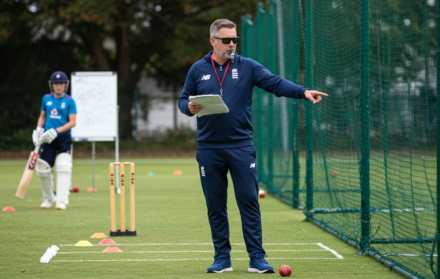
Nathan Ellis: The Death Bowling Specialist No One’s Talking About
In an age of algorithm-driven T20 selection, where players are often measured by economy rates, dot-ball percentages, and social media highlights, Nathan Ellis has quietly become one of the most dependable death bowlers in the global game—without becoming a headline. No fireworks. No controversy. Just control under pressure.
Ellis isn’t the archetypal fast bowler. He doesn’t intimidate with pace or brute force. He doesn’t swagger to his mark like a showman. What he does instead is far more valuable: he reads batters, disguises his changes in pace with surgical precision, and lands his yorkers as if he’s bowling with a protractor.
He broke into the Australian T20 setup in 2021 with little fanfare—yet claimed a hat-trick on debut. Since then, he’s gone on to play for franchises around the world, from the Big Bash to the IPL, quietly building a reputation among insiders as a bowler you turn to when the game is on the line. Not flashy. Just ruthless in execution.
And yet, despite his results, Ellis remains curiously under-discussed—especially in a cricketing culture obsessed with big names and bigger egos. This article peels back the curtain on a bowler whose craft deserves more attention, especially in an era where death overs often decide titles.
1. The Skillset That Thrives When Others Panic

There’s a point in every T20 match where numbers give way to nerves. The final three overs. Twenty balls. A dozen possible outcomes. And usually, it’s the bowlers who suffer.
Not Ellis.
What makes Nathan Ellis so effective in the death overs isn’t just his skill—though that’s considerable—it’s his temperament. He bowls with a clarity that’s rare in chaos, never rushing, never overcompensating, and never telegraphing his intent. Where others flinch, he thinks.
Unlike bowlers who rely on express pace to survive the death, Ellis depends on variety. His slower ball is not only disguised but arrives like a whisper—a delivery that batters can read only after they’ve already committed. His yorkers aren’t thunderous, but they’re immaculately placed, attacking the base of the stumps or the wide tramline depending on the batter’s set-up. He rarely misses by more than an inch.
But it’s not just the mechanics. It’s the sequencing. Ellis understands patterns. He’ll bowl back-of-a-length cutters for three deliveries, only to surprise with a dipping full ball that rushes the toes. He uses the crease subtly—wider angles for left-handers, straighter lines to set up off-side traps.
This isn’t guesswork. It’s planning married to calm execution. And in most franchises he plays for—Hobart Hurricanes in the BBL, Punjab Kings in the IPL—Ellis is trusted with the crunch overs because he’s one of the few who sees them as opportunity, not burden.
What’s most impressive? He’s doing this without the protective aura of superstardom. Batters still think they can get after him. That belief often disappears by the second ball of the over.
2. A Hat-Trick on Debut, Then Back to the Shadows
In most cricketing nations, a T20 hat-trick on debut would trigger a media frenzy, endorsement deals, and a guaranteed run in the national team. But Nathan Ellis achieved the feat in August 2021—and barely made a ripple outside the serious analyst circles.
Bowling in the final over against Bangladesh, Ellis removed Mahmudullah, Mehidy Hasan, and Mustafizur Rahman with his last three deliveries. It was surgical rather than spectacular—lengths adjusted by centimetres, deliveries landing like they’d been scripted. No wild celebrations. Just a quiet smile and a subdued high-five from teammates. A bowler doing his job.
But the cricketing spotlight moved on, as it often does when the wicket column isn’t filled with big names. Australia’s pace arsenal is crowded—Hazlewood, Starc, Cummins—and Ellis, with his understated pace and precision tools, has often found himself on the periphery, picked as injury cover or benched for tournament crunch matches.
And yet, when given the ball, he performs. Consistently. In 2023, he was entrusted with death overs during Australia’s tours against India and New Zealand—both notoriously brutal environments for bowlers. In each series, he delivered overs that bent the arc of the match, keeping his economy under control and dismissing key batters with barely a grimace.
What’s become clear is that Ellis doesn’t need a stage to prove his worth. He just needs six deliveries and a bit of trust. He’s not in cricket for the profile—he’s there to compete. And when he does, results tend to follow.
He’s the kind of bowler who might not sell jerseys but will win you games—and that, in the end, should matter more than any marketing package.
3. Franchise Cricket’s Hidden Gem

While his name rarely trends on social media, Ellis is slowly becoming one of the most quietly coveted white-ball assets across global leagues. It’s not because he draws crowds—it’s because he wins respect inside dressing rooms.
At the Hobart Hurricanes, Ellis has been a mainstay, particularly in tight finishes. In the 2022-23 Big Bash League season, his death-over stats were among the most impressive in the competition. He bowled more overs at the back end than any other Hurricanes bowler, with an economy rate just under 8—a rare figure in an era of brutal end-overs acceleration.
His performances in the IPL with Punjab Kings followed a similar arc. In a team full of firepower and unpredictability, Ellis stood out for his control. He wasn’t the first name on the team sheet, but when picked, he often closed out overs with a calm that belied the occasion.
What makes him especially valuable in franchise setups is his low maintenance. He doesn’t demand the new ball. He doesn’t lobby for specific phases. He adapts. Whether it’s coming on after the powerplay or delivering the 19th over, he maintains the same rhythm and temperament. Coaches love that. Captains, even more.
His lower profile has, in some ways, been a blessing. He flies under the radar, works relentlessly on variations, and avoids the fatigue that comes with overexposure. The players know his value, even if the headlines don’t.
In the high-stakes ecosystem of modern T20 leagues, Nathan Ellis is the insurance policy everyone wants but few talk about.
4. What Makes His Craft So Underrated
The art of death bowling is often misrepresented. It isn’t just about raw pace or bowling yorkers—it’s about constructing an over under pressure, understanding the batter’s intent, and executing a plan when the margins for error are razor-thin. Nathan Ellis excels in this realm because he’s a student of micro-decisions.
He adjusts fields almost ball-to-ball, not just reacting to boundaries but pre-empting them. His slower balls aren’t variations for variation’s sake; each is deployed with purpose, designed to exploit matchups or specific pitch characteristics. His short-of-a-length cutters work especially well on sticky surfaces, while his dipping full balls find value even on true tracks.
What’s often missed in broader discussions is that Ellis rarely bowls a ‘bad’ ball. Even when he’s hit, it’s more often a calculated risk—testing a line or length that had worked previously. And when he does get taken apart, there’s no panic. He resets, recalibrates, and returns with sharper execution.
It’s also notable how his technique remains repeatable under fatigue. Where others lose rhythm in the back half of a spell, Ellis sustains control. That’s not luck—it’s the result of a biomechanically efficient action that minimises strain and maximises accuracy.
But perhaps what really keeps him underrated is the quiet way he carries it all. He doesn’t seek post-match interviews. He doesn’t churn out viral moments. He’s content being the one who gets it done when it matters, then disappears into the background until he’s called upon again.
5. Why Australia Should Look Closer

The Australian T20 setup has historically favoured high-velocity, hit-the-deck quicks who intimidate with body language and break stumps with brute force. It’s a formula that’s worked—until it hasn’t.
In recent tournaments, Australia’s death bowling has looked vulnerable. High run chases, poor end-overs control, and an over-reliance on frontline pacers with predictable lengths have led to exits that feel preventable. This is where Nathan Ellis fits not as a gamble, but a solution.
Unlike the big three—Cummins, Starc, Hazlewood—Ellis doesn’t come with red-ball obligations or workload management caveats. He’s a white-ball specialist who knows his role and isn’t trying to be anyone else. His game is suited to slow, low subcontinental pitches and high-pressure knockout matches—precisely the kind of environments where Australia has faltered.
Yet, despite his effectiveness, Ellis is often treated like a backup. The “next man in” when someone’s injured. The squad option who warms up but doesn’t play. And that’s a mistake. Because when you assess impact per delivery, especially in the final five overs, Ellis is statistically among Australia’s most efficient bowlers.
Selectors often talk about “horses for courses.” Ellis isn’t just that. He’s a course-corrector. The kind of bowler who can change the outcome of close games not through brute force, but clarity of execution.
If Australia wants to adapt to the demands of modern white-ball cricket, Ellis should be central to that shift—not peripheral.
6. The Quiet Consistency Behind the Stats
In white-ball cricket, consistency is gold—but it’s also elusive. Even the best bowlers are occasionally carted in flat conditions or by in-form hitters. What separates Ellis is not an immunity to being hit, but his ability to limit damage over time.
In the 2023–24 T20 cycle, Ellis’s economy rate in the death overs sat around the 7.8–8.2 mark, depending on the league. In raw terms, that’s elite. But context makes it even more impressive: he’s rarely bowling with huge scoreboard pressure behind him or cushy matchups. He’s often handed the toughest overs—18th or 20th—against set batters trying to finish strong.
Ellis is not a mystery spinner or an express quick. His tools are visible. What’s less visible—and more valuable—is how few bad days he has. His spells don’t oscillate wildly between brilliance and disaster. They tend to land in a tight band of dependable control. When your team needs to defend 10 in the final over, you don’t want volatility. You want Nathan Ellis.
It’s this steady base of execution that’s slowly earning him trust in dugouts, if not headlines. His captain doesn’t worry when he has the ball. His coach doesn’t wince when the game hangs in the balance.
And while cricket loves a redemption arc or a breakout story, Ellis offers something different—an anti-narrative. Just a quiet man doing a brutally difficult job, and doing it better than most.
7. Lessons for the Next Generation

Ellis’s rise isn’t just inspirational—it’s instructive. Aspiring fast bowlers, especially those not gifted with express pace or a six-foot-five frame, often believe their path to the top is blocked. Ellis proves that’s false.
What he offers is a model: of craft over spectacle, of repetition over raw talent. Young bowlers watching him should study not just what he bowls, but how he prepares. His discipline in analysing batters, his humility in roles, and his ability to evolve quietly from domestic hopeful to global finisher—all of it speaks to a process that can be emulated.
Moreover, Ellis reminds cricket that specialist roles matter. He’s not a bowler trying to bat at No. 7 or a seamer auditioning for red-ball formats. He’s embraced the niche. And in a world where many cricketers chase multi-format careers, that sort of clarity is rare—and often more impactful.
For coaches and systems that still undervalue T20 specialists, Ellis is a wake-up call. Not every match-winner walks in with a central contract. Some arrive from the edges, sharpened by limited opportunities and long flights between leagues.
That he made it this far is a testament not just to his skill, but to his belief that even in modern cricket’s chaos, execution still reigns.
Conclusion: Why Nathan Ellis Is the Death Bowling Specialist No One’s Talking About

It’s easy to miss Nathan Ellis. He doesn’t command headlines or dominate marketing campaigns. But every team he plays for, at some point, realises a fundamental truth: when the game’s on the line, you want him with the ball in hand.
He’s built his reputation not on pace or personality, but on precision and poise. In a cricketing landscape that often values loud over lasting, Ellis has found a way to matter deeply without shouting for attention. And he’s done it through relentless skill.
Australia, and indeed the broader cricketing world, may soon find themselves needing someone who can turn tight matches without theatrics—just with thoughtful, world-class execution. That someone is already here. And he’s been doing it quietly for years.
In a game where the difference between champions and also-rans often comes down to the final overs, Nathan Ellis offers a rare commodity: certainty when it counts most.
It’s time the conversation caught up with the performance.





